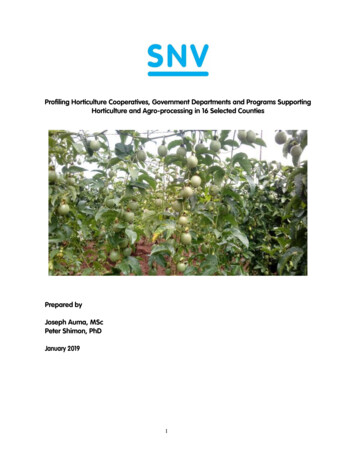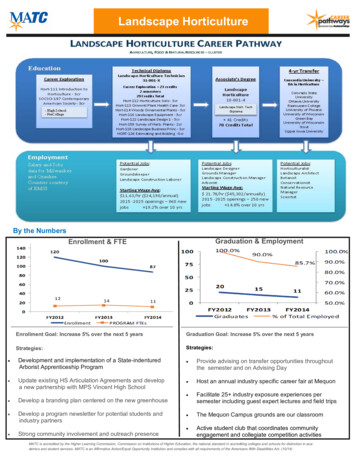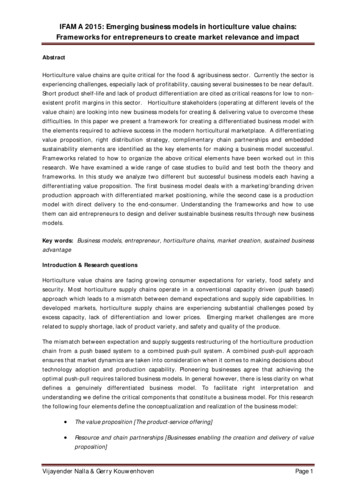
Transcription
Cover StoryBy: Kanishka GuptahorticultureFRUITS OF LABOURThe horticulture sector contributes about 24.5 per cent of India’s GDP. At present, horticulturalcrops occupy around 13 per cent of India’s gross cropped area with a total output of 214.7million tonnes during 2008-09 valued at Rs 6,769 billion. The horticulture sector encompasses awide range of crops like fruits, vegetables, potato and tuber, ornamental plants, medicinal andaromatic crops, and spices and plantation crops. Indian companies like Agrisolutions,Champion Agro, Vegetable Processing Machines, BEE CHEMS and Plantsman’s Seeds haverisen to the challenges in this sector and are servicing a wide array of clients.Opportunities in thehorticulture businessare available acrossthe value chain—right from productionto storage, distribution and marketing of fresh and value-added products both for domestic consumptionand exports. India is one countryblessed by nature to have production and availability of one or morefruits at any point of the year. Witha production increase of over 300 percent during the last three decades,it today stands second in the worldproduction of fruits and vegetables.Yet, India’s share in the world tradeis miniscule at less than 2 per cent.In food processing, India’s share isless than 2 per cent as against 30 percent in Thailand, 70 per cent in Brazil, 78 per cent in Philippines and 80per cent in Malaysia. Value additionin the food sector is as low as 7 percent.Increasing awareness among thefarmers about new methods of agricultural production like protectedChampion Agro greenhousecultivation via greenhouses, supports and subsidies from the government for establishment of infrastructure facilities like cold chain,pack house and refrigerated vans,and technology advancement clearlyreflects that the horticulture busi-ness is full of opportunities and hasa very promising outlook.Industry gung-ho“India’s long growing-season,diverse soil and climatic conditionsFebruary 2011 FACTS FOR YOU9
Cover StoryIndia’s long growing-season, diverse soil andclimatic conditions comprising several agroecological regions provide ample opportunityto grow a variety of horticulture crops. Itis these conducive conditions that provideample opportunities to those interested in entering thehorticulture business — Anil Chopra, managing director, Agrisolutionscomprising several agro-ecologicalregions provide ample opportunityto grow a variety of horticulturecrops. It is these conducive conditions that provide ample opportunities to those interested in enteringthe horticulture business,” says AnilChopra, managing director, Agrisolutions, which provides innovativefarm-to-market business solutionsin retail and wholesale segments offresh, frozen, fresh-cut, dehydratedand processed fruits and vegetables.Maheshwar Dutt Sharma, director & CEO, Allround (India) Vegetable Processing Machines, says, “Theopportunities in the horticulturebusiness in India are tremendous ifwe prepare ourselves to minimisethe exceptionally high post-harvestlosses of horticultural crops to meetthe nutritional demands of the vastpopulation of the country. The policies of the Indian government in developing cold chains, processing anddistribution for horticultural cropshave also attracted enterpreneursat various levels. The challenge is tohygienically and efficiently bring thecrop from farm to fork. Any size ofenterpreneurship is possible in thishuge chain.” Allround (India) Vegetable Processing Machines, under its“Crop-to-Shop” mission, producesand supplies all machines under oneroof catering to the needs of farmersand processors.Somendra Bhalla, CEO, BEECHEMS, adds, “There are a lot ofopportunities especially as the Indi10FACTS FOR YOU February 2011an market is very unorganised. Foodresources are going to get scarce bythe day and India being the secondlargest producer of fruits and vegetables, nearly all areas of horticultureincluding farming, transportation,packing, storage and retail offer a lotof opportunity.” BEE CHEMS offersa number of post-harvest preservation solutions which help in increasing the shelf life and retaining thefreshness of fruits, flowers and vegetables.Severe inefficienciesThere are, however, limitationsin the horticulture sector. “Whilethe area and production has beenincreasing at a fast pace, still 25-35per cent of the horticulture producegoes waste due to improper postharvest operations. According to anestimate, 35 per cent of the perishable (fruits and vegetables) produceworth Rs 350 billion and 12 per centof non-perishable produce worth Rs150 billion are lost due to poor harvest and lack of storage and processing,” informs Dhirajlal G. Hipara,chairman and managing director,Champion Agro—a company whichprovides a one-stop solution fromsetting up greenhouses to outputprocurement and contract farmingto people who have agri land andagro centres.“The Indian horticulture sectoris facing severe inefficiencies such aslow crop productivity, limited irriga-tion facilities and underdevelopedinfrastructure support (cold storages, markets, roads, transportation facilities, processing etc),” saysChopra.“the business is very uncertain,it requires a long gestation period,the capital employed can be usedonly once a year, the labour cost isvery high and opportunities existonly for those farm owners who canput in long hours of manual labour.Further, efficiency is very important in this business,” adds A. Wahid, managing director, Plantsman’sSeeds—a company into the businessof production of plants, landscaping,seed production and export of flowerseeds to Indian and foreign markets.Support by theGovernment of IndiaThe Indian government is currently undertaking several initiatives in the form of schemes andpolicies for the development of thehorticulture sector and fruit andvegetable processing in India. Onthe macro scale, the three major associated government ministries are:Ministry of Agriculture, Ministry ofFood Processing Industries, and theMinistry of Commerce and Industrythrough the Agricultural and Processes Food Products Export Development Authority.Schemes and incentives spandevelopment of commercial horticulture through production andpost-harvest management, capitalinvestment subsidies for modernisation of cold storages, technologydevelopment/transfer, market information services, promotions, production of cost-intensive crops, organic farming, pollination support,integrated post-harvest management, establishment of marketinginfrastructure, mega infrastructuredevelopment, technology upgradation, quality assurance, human resource development, market devel-
Cover Storyopment and R&D to name a few.Different authorities like theNational Horticulture Board, theNational Horticulture Mission andthe Ministry of Food Processing Industries through various schemesare providing technical, financial,logistics, micro irrigation system(MIS), consultancy and marketingsupport with back-ended capital subsidy up to 70 per cent for creation ofthe infrastructure (cold chains andpack houses, greenhouses, terminalmarkets, etc). Various schemes havebeen launched for providing the necessary impetus to the growth of thehorticultural sector. These includeschemes for training of entrepreneurs, creation of infrastructuralfacilities for fruits and vegetablesprocessing including mushroomprocessing, HOPS (characterised asbines, having thick vines and tenacious hairs which enable them toclimb any structure in a clockwisedirection) and industrial estates,settingup/expansion/upgradationof fruit and vegetable preservation(F&VP) units and development ofbackward linkages through contract farming, market promotionthrough advertisement, promotionof food products order (FPO) symbol and marketing of small manufacturers’ products under commonbrand name, setting up of qualitycontrol labs and R&D in identifying new techniques and practicesincluding those for packaging. Apartfrom these, tax exemptions and taxholidays are also being provided tothe states and sectors under variousschemes.Further, GoI is supporting companies in the development of infrastructure. The government is funding capital to the tune of 25-50 percent of the cost of infrastructure,seed processing plants, refrigerators,logistics, freight subsidy, etc. It alsohas various subsidy schemes, even atgrassroot level, right from supplyingsubsidised pesticides, fertilisers andWhile the area and production has beenincreasing at a fast pace, still 25-35 percent of the horticulture produce goes wastedue to improper post-harvest operations.According to an estimate, 35 per cent ofthe perishable (fruits and vegetables) produce worth Rs 350billion and 12 per cent of non-perishable produce worthRs 150 billion are lost due to poor harvest and lack of storageand processing — Dhirajlal G. Hipara, chairman and managing director, ChampionAgro Ltdimplements to giving up to 40 percent subsidy on bigger integratedhorticultural projects through various agencies and banks in all thestates.The identification of processingzones and proposed mega food parksin various states is part of the government policies in promoting horticulture. The government has alsocome up with various schemes oflate to help improve the infrastructure and supply chain issues relatedto the industry. Various horticultureboards of different states are working with farmers and traders tomake them aware of the opportunities and the schemes available fromthe Central government to improvetheir setup and scale up operations.Latest technologiesProduction and post-harvestmanagement are the two broad categories where latest technologiesare being deployed for improvinghorticulture crops. Latest technologies for improvement in productionof horticulture crops are more in thebiotechnological applications liketissue culture, micro-propagation,embryo rescue and culture, abioticstress tolerance, flowering and sexdetermination, somatic hybridisation, germplasm conservation, genetic engineering, disease and pestresistance, use of marker, etc. Inaddition, greenhouse technology forplant propagation and production,commercial grafting techniqueswith computer control, hybrid seedand seedling production, crops under protected environment, highdensity planting, micro-irrigationand fertigation, organic farming andintegrated pest management arebringing huge improvements in horticultural crops.In the post-harvest improvementcategory, mechanisation of harvesting and post-harvest handlingseparation, modern techniques andgadgets based on photometry, acoustic response, short-wave radiation,machine vision and laser technology hold promise to meet qualitystandards for markets and operations down-the-line including valueaddition. Appropriate heat removaltechniques, viz, cold-air system,hydro-cooling, vacuum cooling orslush system, are being adopted atthe field level in addition to havingenvironmental and climatic controlstorages with automation.“In addition, technologies arehelping improve processing and value addition for horticultural crops.For example, minimal processing forquick cooking of vegetables and theirproducts, which are prepared withintermediate moisture and hurdletechnology, dehydration and freezFebruary 2011 FACTS FOR YOU11
Cover StoryThe policies of the Indian governmentin developing cold chains, processingand distribution for horticultural cropshave attracted enterpreneurs at variouslevels. The challenge is to hygienically andefficiently bring the crop from farm to fork. Any size ofenterpreneurship is possible in this huge chain — Maheshwar DuttSharma, Director & CEO, Allround (India) Vegetable Processing Machinesing using various technologies havegreat potential. Our company provides consulting services through itsempaneled experts across the worldfor the benefit of those who are interested in implementing these technologies,” says Chopra.To combat the issue of smallerland holding due to increasing population and to meet the internationalstandards taking into considerationthe soil health, hi-tech protected cultivation system (Greenhouse technology) is being encouraged. It helpsto meet the global demands withoutstraining the available resources.Technology focusing on the improvement of the soil condition is nowavailable in the market. cold storageand packhouses with referred vanswould help to minimise the post-harvest losses. With the support of ICTand high-quality extension services,these facilities are finding their wayto the food value chain.“Genetically modifying thecrops for immunity, nutrition andshelf life has of late revolutionisedhorticuture. Though it is a beginning, a lot needs to be done. Theadvanced techniques of pre- andpost-harvest handling, processing,storage and distribution of fruitsand vegetables by high-tech machines and techniques is slowlybecoming popular and affordableamong the processors and farmers due to the relevant governmentpolicies,” adds Sharma.12FACTS FOR YOU February 2011However, there is a lot of confusion regarding the technology. SaysWahid, “The government continuesto stick to and support one kind oftechnology. This approach generallyfails. Due to this, many polyhouseshave failed in north India. Many corporate houses which ventured intofarm production—like Mahindra &Mahindra, Reliance and Feel Fresh/Airtel—have failed. The main reason is that professional managersthey hired to work only for 8 hoursat very high salaries with no farmexperience, compete with farmerswho own the land and work 18 hoursa day.”Value addition andquality issuesThe extent of value addition ofhorticultural products in India ishardly 7 per cent and the post-harvest losses are high at almost 30 percent. These statistics present a grimpicture when compared with thedeveloped countries like USA andFrance, which have value-additionto the extent of 70 and 50 per cent,respectively, with minimal wastages.Even the developing countries suchas Malaysia and Brazil encouragevalue-addition of horticultural exports, which at present stands at 80a
The horticulture sector contributes about 24.5 per cent of India’s GDP. At present, horticultural crops occupy around 13 per cent of India’s gross cropped area with a total output of 214.7 million tonnes during 2008-09 valued at Rs 6,769 billion. The horticulture sector encompasses a wide range of crops like fruits, vegetables, potato and tuber, ornamental plants, medicinal and aromatic .











